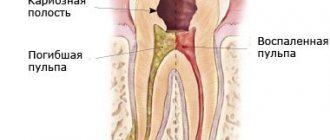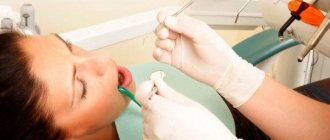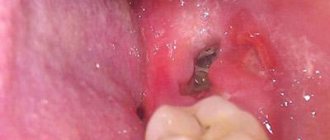Pain after tooth extraction
After the tooth is removed and the anesthesia wears off, the patient may experience minor pain, which usually goes away quickly. However, sometimes 1-3 days after surgery a sharp pain appears in the area of the socket of the extracted tooth .
Taking analgesics does not bring relief. This pain most often occurs due to disruption of the normal healing process of the tooth socket. In addition, the pain may be caused by the remaining sharp edges of the socket or by an exposed area of the alveolar bone not covered with soft tissue.
How pain goes beyond the norm
Sometimes the pain goes beyond the norm
The pain is intense, does not subside, increases or maintains amplitude, lasts more than 3-4 days, this ceases to fit into the framework of the body’s natural pain reaction, which must be endured. There are very specific causes of pathological pain after tooth extraction.
Poor quality treatment. The practice of dentistry is as susceptible to human error as any activity involving humans. Often the surgeon does not completely remove the root, leaving part of the dental tissue, cyst fragments, a piece of cotton wool, or a fragment of dental bone in the wound. All this becomes a source of inflammation. And after a few days the inflammatory process begins to actively develop.
If after removal a root fragment remains in the gum, an inflammatory process may begin.
Alveolitis. The cause of pain is the absence of a blood clot. Any wound, especially in the gum, needs a blood clot to close it to heal the tissue and block the path of infection. After a tooth is removed, this clot forms in the socket. But for various reasons it turns out to be broken or shifted. Patients also often wash out this clot, for example, when they begin to rinse the wound. As a result, the root hole remains open, infection gets into it, inflammation and swelling of the gums begin. All this is accompanied by pain, which normally should not be present.
In the photo there is alveolitis of the tooth
By the way. If a patient has to have a simple (single-rooted) tooth removed, according to statistics, alveolitis occurs in 3% of 100. When a complex tooth is removed, this figure rises to 20%.
Dry socket . This is the most common complication, also associated with the absence of a formed blood clot, but with it the hole from the root, upon careful examination, remains dry, despite the moist environment in the mouth, and bone is visible at the bottom of the hole. This problem is more likely to occur in smokers, older people, and those who have hormonal problems. The pain in this case will be quite severe. And you shouldn’t wait until it goes away; the doctor will help by putting a tampon with medicine in the wound that will moisturize and disinfect it.
Photo of a dry socket after tooth extraction
Trigeminal neuritis . This cause of ongoing and unrelenting pain is familiar to patients who have had a lower row tooth removed. The lower jaw serves as a receptacle for the branched trigeminal nerve. A dentist, diligently pulling out a deep-seated tooth root, can damage this nerve. The probability is low - only about 10%. But if you fall into this number, the pain after removal and the end of the freezing effect will be “shooting”, paroxysmal, not only in the gums and jaw, but also in the temples, around the eyes, even in the neck. Externally, the gums do not swell and do not look damaged, even redness is not observed. It is possible to identify neuritis only by the nature of the pain.
- How many days does a coma last after a stroke and is there a chance of survival?
Trigeminal neuralgia
Gum tumor
Often pain from an extracted tooth is accompanied by gum swelling. The phenomenon is not only not aesthetic, but, at times, dangerous.
In about half of removal cases, swelling after surgery is normal. It is associated with soft tissue injury. And if the swelling is temporary and transient. There is nothing to worry about, you just need to “get over it.”
Swelling of the gums after tooth extraction
But if the phenomenon is accompanied by atypical pain that lasts longer than expected. Perhaps this is a pathology that a repeat visit to the surgeon will help normalize.
- Inflammatory process. Often it is already present when the patient presents for tooth extraction surgery. And the source of inflammation is not always removed when the tooth is extracted. Trauma to the soft tissue allows inflammation to begin again. Plus insufficient antiseptic treatment of the hole or alveolitis.
- A complex tooth - impacted or dystopic - its removal will almost certainly involve the fact that the surgeon will open the mucous membrane over a large area and will spend a long time “pulling out” the tooth. Of course, the cheek, gums, even the neck and skin near the ear can become swollen and painful.
Atraumatic tooth extraction
- Gum section. Sometimes the surgeon sees suspicious swelling of the gums already during the operation, and mistaking it for an abscess (in most cases, rightly) cuts the gum. Thus, the extracted tooth will hurt much stronger, longer, and with accompanying swelling of nearby soft tissues.
Photo after tooth extraction. During the operation it became necessary to apply sutures
There is nothing to worry about if the swelling is expressed as follows:
- the swelling is not pronounced and decreases over time;
- the temperature is not elevated;
- moderate pain;
- there is no unpleasant odor from the mouth.
By the way. There are exceptional cases when there is no severe pain from the extracted tooth, but there is a swelling of the cheek, and it is growing. It does not happen often, mainly after the removal of a tooth with pulpitis, if the root canals are not very thoroughly cleaned. In this case, you need a second visit to the surgeon to prevent the formation of a cyst.
If your cheek is swollen, you need to visit the dental surgeon again
If the condition does not improve, but worsens at least slightly or the pain remains stable. If new aggravating symptoms appear that were not present immediately after removal. You shouldn’t delay visiting a doctor; it’s better to play it safe and make an appointment for an examination.
It's time to go to the doctor
If you observe the following symptoms in yourself or your loved ones for several days after tooth extraction surgery (more than three days):
- pain intensifies;
- the pain changes in character or is specific;
- gums become red;
- gums have acquired a bluish tint;
- swollen gums;
- there is a bad smell from the mouth;
- cheek swollen;
- body temperature increased;
- Pus comes out of the root socket of the tooth.
If your cheek is swollen, your temperature has risen, or your condition is worsening, then you should not postpone a visit to the doctor.
Important! The area in the gum begins to hurt after tooth extraction three hours later. Normally, pain can be intermittent or constant, subsiding or recurring. Starting from the third day, the pain decreases and disappears completely.
Video: Cheek swollen after tooth extraction - what to do
Difficult case
All previous characteristics relate to conventional tooth extraction, with one or more roots. But there are times when the operation goes beyond the standard surgical procedure. These include the removal of a dystopic wisdom tooth. During this operation, which takes longer, all tissues are injured much more than during standard removal. Here, pain is allowed in the postoperative period for up to one and a half weeks. The pain may also be accompanied by swelling of the gums, a swollen cheek, headaches, and neck pain. All these symptoms are considered not dangerous and go away without medical or other intervention.
Wisdom tooth removal
Alveolitis
Inflammation of the walls of the socket.
- In the initial stage of alveolitis, an intermittent aching pain appears in the socket, which intensifies while eating;
- The general condition is not disturbed, the body temperature is normal;
- The tooth socket is only partially filled with a loose, disintegrating blood clot.
With further development of inflammation:
- The pain intensifies and becomes constant;
- Transmitted to the ear, temple, corresponding half of the head;
- The general condition worsens, malaise and fever appear.
Limited osteomyelitis of the tooth socket
Inflammation of the bone tissue in the area of the extracted tooth :
- in the socket of the extracted tooth , and pain occurs in the adjacent teeth;
- Weakness, severe headache;
- Body temperature is 37.6-37.8°C and above, sometimes there is chills;
- Loss of sleep and performance;
- The bottom and walls of the hole are covered with a dirty gray mass with a fetid odor;
- Touching the gum is sharply painful;
- When you tap adjacent teeth, pain occurs;
- The perimandibular soft tissues are swollen, the submandibular lymph nodes are enlarged, dense, painful;
The symptoms of acute inflammation last 6-8 days, sometimes 10 days, then they decrease, the process passes into the subacute and then into the chronic stage.
- The pain becomes dull and weak;
- General condition improves;
- Body temperature normalizes;
- After 12-15 days, the tooth socket is filled with loose, sometimes protruding pathological granulation tissue, which, when pressed, releases pus.
Please note that pain relief during a complication does not mean that the process has begun to heal; perhaps it has entered a chronic, more dangerous stage. As a rule, the surgeon schedules a follow-up examination for the patient after removal; ATTENDANCE IS MANDATORY!
Ways to eliminate the pain reaction
All medications are prescribed individually. The doctor selects treatment methods only after examining and establishing the cause of the problem. However, some aspects of pain management are suitable for everyone.
They are as follows:
- Immediately after surgery, it is recommended to apply a cold compress to the cheek. If ice is used, it should be applied through a thin cloth. It is necessary to observe the time regime and not to overcool the well.
- Start rinsing on the second or third day after surgery. The best antiseptic solution is regular baking soda and salt. To prepare it, take half a teaspoon of these components and thoroughly dissolve it in boiled water at room temperature. Rinse 3-4 times a day, especially after meals.
- If there is an inflammatory process, the doctor must start antibacterial drugs. Amoxiclav, Sumamed, Biseptol have a good effect. These medications are taken even after all symptoms have subsided. It is important to follow the course prescribed by the doctor.
- At home, if throbbing pain occurs, antiseptic irrigation and oral baths are indicated. The most commonly used are Chlorhexidine, Miramistin, Rivanol, Rotocan, Stomatofit, Iodinol. The price of the drugs is insignificant, but their high effectiveness has been proven in practice many times.
- If the unpleasant sensation increases, painkillers such as Analgin, Diclofenac, Ketanov are indicated. You should not use antispasmodic drugs, as they have a completely different effect and are not able to help in this situation.
Antiseptic solutions for rinsing the mouth for inflammation of the socket
To prevent the development of a pain reaction, it is necessary to adhere to the following recommendations:
- after tamponade of the hole, the gauze pad must be kept in the oral cavity for half an hour;
- do not eat for 3-4 hours;
- it is necessary to keep the blood clot in the socket and protect it in every possible way for about a day after extraction;
- It is forbidden to apply dry heat to the cheek, take a bath, visit a sauna, or use hot antiseptic solutions;
- for three days you should not eat spicy, too sour, salty or hard foods;
- avoid hypothermia of the wound if removal occurred in winter;
- You should not use alternative medicine to relieve pain, as they can lead to purulent complications;
- hot drinks and alcohol are prohibited;
- Avoid contact of the wound surface with household items.
It is important to follow all dentist recommendations for oral care. After the tooth is removed from the alveolar process, traditional cleaning can be carried out two days later.
If the pain reaction increases, you should not take painkillers endlessly. It is better to contact your dentist for help as soon as possible, and do not use any medications, including analgesics, during the next few hours of your visit. During this period, only the application of cold to the area where the operation is performed is allowed.
Sometimes it happens that after surgery the gums pulsate and the tooth that is located next to the removed one hurts. The reason for this manifestation could be injury to the pulp tissue in the “neighboring” tooth, if its roots were located very close to the roots of the exposed unit.
As a result, the vascular-nerve bundle of fibers that enter through the apical foramen in the area of the root apexes and nourish the pulp tissue is damaged. In this case, the tooth will have to be opened and treated according to the type of acute pulpitis.
Sharp edges of the alveoli
Socket pain can be caused by protruding sharp edges of the socket, which injure the mucous membrane located above them. Pain appears 1-2 days after tooth extraction , when the edges of the gums above the socket begin to approach each other.
- The pain intensifies during chewing and when touching the gums;
- When you feel the hole with your finger, a protruding sharp edge of the bone is detected, and a sharp pain occurs.
This pain can be distinguished from the pain of alveolitis by the absence of inflammation in the socket area and the presence of an organizing blood clot in it.
Dangerous complications of long-term pain
Ignoring pain and tissue swelling can lead to serious complications that may require surgery.
When the inflammatory process is advanced, purulent foci form in the tissues, increasing the risk of pus spreading through the bloodstream throughout the body. The development of phlegmon and destruction of the jawbone is likely. With a hematoma, a thickening of the clot may occur, which will inevitably lead to the need for surgical intervention, the appearance of scars and an increase in recovery time.
Toothache after caries treatment
Constant pain after filling can occur for many reasons. A common cause of discomfort is the application of an insulating lining made of glass ionomer cement (GIC) and filling on the same day with a composite. The polymerization times of GIC and composite differ, which can result in displacement of the gasket and its pressure on the pulp.
If the pain is short-term in nature as a reaction to cold, sour or sweet and quickly passes after removing the irritant, it may be due to the fact that during the treatment there was a mechanical effect on the pulp. After 2-3 days, the pulp will return to normal functioning and the pain will stop.
If you experience pain when biting, you need your dentist to grind the filling to fit your bite.
Relieving pain with folk remedies
If you experience headaches after a recent visit to the dentist, you must first identify the cause of the disease. It is impossible to do this on your own without visiting a doctor. You can use some traditional medicines, but you should consult your doctor before using them.
- Drinking mint tea is good for eliminating cramps and reducing headaches;
- Freshly prepared viburnum juice - drink one hundred grams for headaches twice a day for five days;
- The use of hot foot baths is a proven folk method for relieving headaches;
You should know that the occurrence of headaches after dental treatment may be one of the first prerequisites for the occurrence of more dangerous diseases.
Painful sensations mean that inflammatory processes are occurring in the body, so you need to consult a specialist; you should not self-medicate. Moscow metro station Zvezdnaya, Danube Avenue, 23











